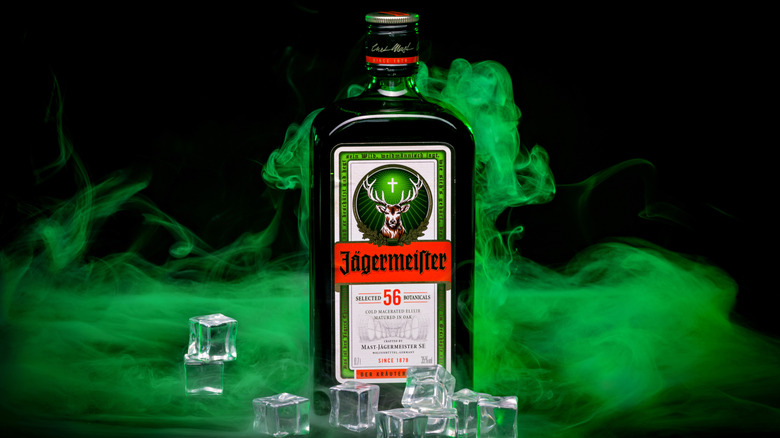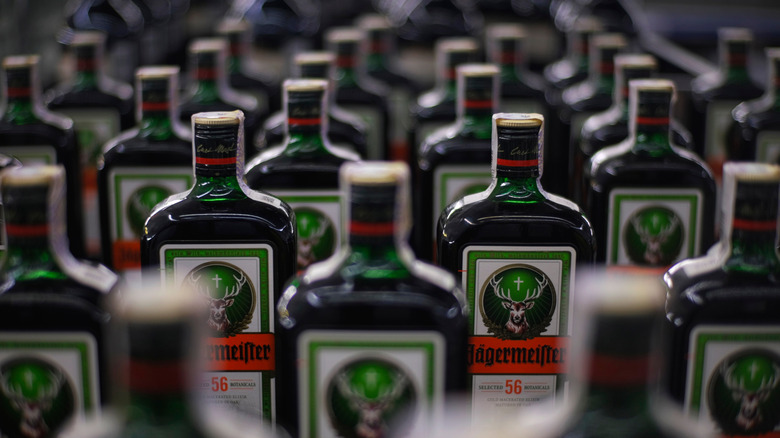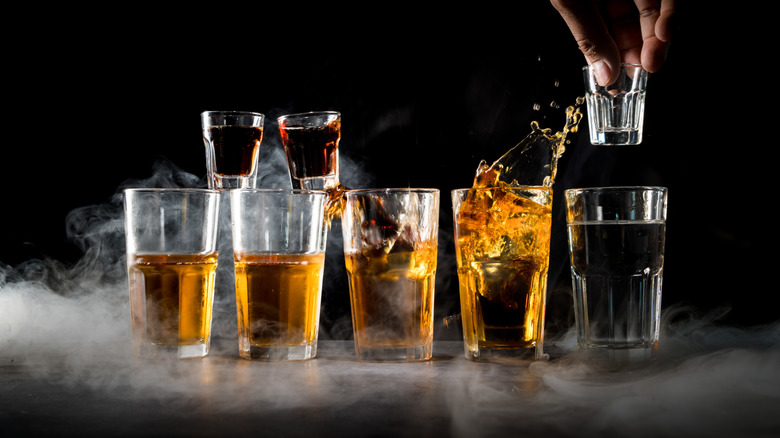How Jägermeister Went From A Nazi Favorite To A Frat House Staple
Jägermeister's journey from the depths of Nazi Germany to becoming a staple of college parties is one of the most peculiar transformations in beverage history. In its early days, this herbaceous liqueur wasn't a symbol of carefree fun but a drink heavily tied to the upper echelons of Germany's well-known dark past. The iconic green bottle, with its stag logo and medicinal aura was once marketed as a drink for hunters, war veterans, and even soldiers under Hitler's regime.
Fast forward a few decades, and Jägermeister underwent a radical rebranding, shedding its controversial past to embrace a completely different audience, and going from Führer to fraternities. Now, it's synonymous with frat house debauchery, Jägerbombs, bad decisions during messy spring breaks, and next morning regrets. But how did a drink so deeply rooted in the propaganda of the Third Reich become a household name at bars and college campuses worldwide? The answer lies in a huge and bold marketing campaign, overall cultural shifts that worked in their favor, and a touch of irony.
A dark past and a bold reinvention
Jägermeister was first introduced in 1934and marketed as a digestif for Germany's hunting elite, quickly becoming a staple in the community. The recipe, steeped in 56 herbs, spices, and roots, has remained unchanged, but its image has undergone a shift of seismic proportions. In Nazi Germany, Jägermeister became a favorite of the military elite, with its association reinforced by clever branding and partnerships with the growing Nazi regime. By the 1970s, however, Jägermeister was ready to escape its shadowy originsand expand to new audiences.
A strategic pivot transformed it from an unpopular, boring digestif into a party icon for young, new drinkers. The brand leaned heavily into the nightlife scene, sponsoring concerts and partnering with bartenders to create signature cocktails. Its breakthrough came with aggressive marketing campaigns that emphasized its bold flavor and carefree image – unlike Krispy Kreme's owners, who chose to make a large donation when they discovered their past Nazi ties instead of rebranding. The Jägerbomb, a mix of Jägermeister and energy drink, played a pivotal role in securing its spot in pop culture, becoming a go-to shot at clubs and house parties alike. Suddenly, the drink that once symbolized solemn tradition was the life of the party. This transformation speaks volumes about how brands can rewrite their narratives, even ones as fraught as Jägermeister's.
A global symbol of party culture
Today, Jägermeister is a far cry from its Nazi-era associations. It's become a global phenomenon, sold in over 150 markets and celebrated as a symbol of fun and rebellion. Its marketing campaigns continue to embrace the brand's youthful and edgy persona, with airport giveaways, concert sponsorships, and collaborations with musicians.
Ironically, the drink's controversial history has only fueled its mystique, making it a conversation starter at parties worldwide. While its past serves as a reminder of the power of propaganda, its present illustrates how reinvention can redefine a brand's legacy. Much like Coca-Cola's Fanta during WWII, Jägermeister's story is a fascinating case of a product transcending its origins. So, next time you raise a shot of Jägermeister, remember: Behind that bold herbal punch lies a history as complex as the drink itself. It's a toast to reinvention, and perhaps a reminder of the stories we don't often think about when enjoying a night out.


